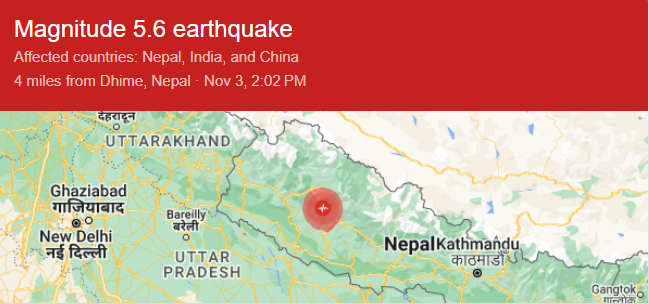The western region of Nepal was rocked by a powerful earthquake late Friday night, claiming at least 157 lives and causing widespread destruction. This seismic event, registering a magnitude of 5.6, is the deadliest to strike the nation since the catastrophic tremors of 2015.
The earthquake's epicenter was situated near the district of Jajarkot, approximately 42 kilometers from Jumla in the Karnali province. The tremors, felt as far as India's capital New Delhi, resulted in the collapse of numerous buildings, leaving survivors to endure the night outside amidst continuous aftershocks and fears of further damage.
Nepal's rugged terrain and remote village locations have posed significant challenges to the ongoing search and rescue operations. According to Kuber Kadayat, a spokesperson for the Nepal police, "We are only focused on search and rescue operation right now," highlighting the urgency of the situation and the yet unassessed full extent of the calamity.
In the districts of Jajarkot and West Rukum, security forces have been mobilized to assist with the emergency response. Despite the deployment of these resources, the relief efforts are being impeded by blocked roads due to quake-triggered landslides.
Survivors recount harrowing experiences, like Geethakumari Bista, who told the BBC of being buried under rubble with her daughters, one of whom tragically did not survive. These personal stories underscore the quake's immediate and devastating impact on families in the region.
Unicef Nepal has expressed its concern for the disaster's impact on children and families, embarking on an assessment of the damage. Meanwhile, Nepal's Prime Minister, Pushpa Kamal Dahal, voiced his sorrow and directed security agencies to prioritize rescue and relief operations.
Homes have been razed to the ground, infrastructure is in ruins, and hospitals in the affected areas, such as in Jajarkot, are inundated with the wounded. The seismic activity in the Himalayan region, due to the convergence of the Indian and Eurasian tectonic plates, makes Nepal vulnerable to earthquakes. The 2015 disaster saw over 9,000 fatalities, and the nation has since worked to rebuild and reinforce its structures against such events.
The international community has taken notice, with India's Prime Minister Narendra Modi expressing his condolences and offering assistance. "Deeply saddened by the loss of lives and damage due to the earthquake in Nepal," Modi conveyed his support through the social media platform X.
As rescue teams continue to comb through the debris, officials like Jajarkot district representative Harish Chandra Sharma warn that the number of casualties is likely to climb. The earthquake, though less powerful than the one in 2015, serves as a stark reminder of the region's vulnerability and the need for sustained efforts in earthquake preparedness and response.
In this challenging time, Nepal faces the dual tasks of managing the immediate crisis and fortifying itself against the enduring threat of seismic upheaval that the geography of the Himalayas presents.






